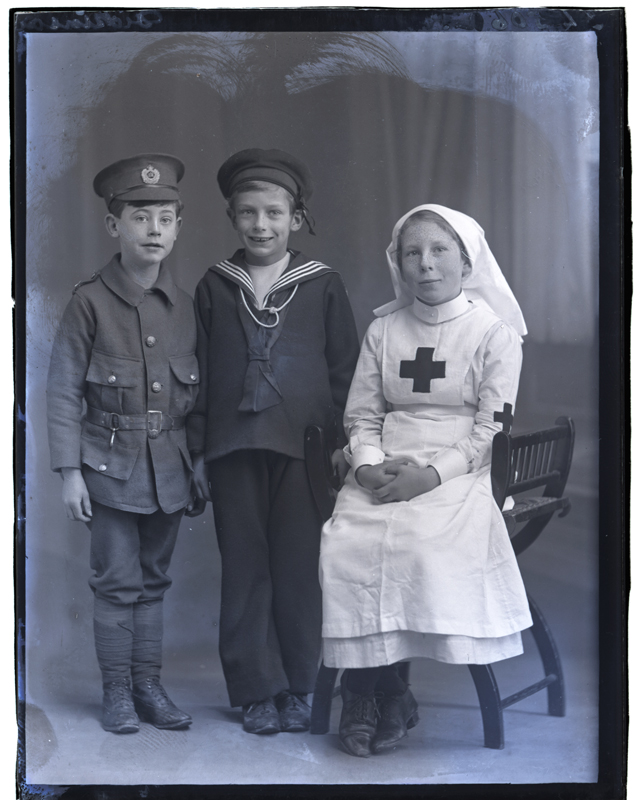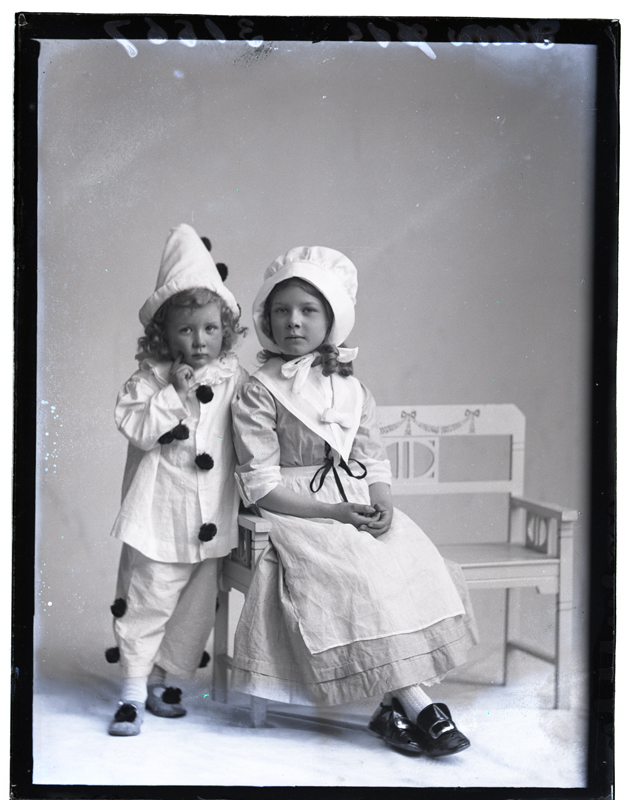Today’s post comes courtesy of Ruth Feather, a remote volunteer who came to us through a family connection with one of our regular hands-on team. Ruth has a particular interest in fashion history having studied the subject for her Masters degree and was fascinated by the examples of fancy dress within the collection. Today she writes a guest post for us about the Edwardian trend for dressing up…
“Whilst browsing the Knights-Whittome Archive I noticed that there were a number of fancy dress portraits. I’m not the first to spot this. There have been at least two previous blog posts on the subject. None the less I thought it would be interesting to do some general research on the phenomenon and put the Knights-Whittome portraits in cultural context.
During the 19th and early 20th Century Balls Fancy Dress Events such as Balls and Masquerades were an important and accepted part of the society and taken very seriously. This was lead from the top, with middle classes striving to emulate the lavish extravaganzas put on by the aristocracy. One of the most photographically well recorded events was the Duchess of Devonshire’s Diamond Jubilee Ball in 1897, which was attended by large number of the aristocratic classes of the time and even some royalty. The firm of Walker & Boutall were hired to take photographs of the guests and an album of their work is available online on the National Portrait Gallery’s webpages. The firm of Walter & Boutall was a partnership between Sir Emery Walker & Walter Boutall. The company had a studio on Fleet Street in the City of London from 1887 until 1900.
There was a whole industry based on supplying costume for events such as these. The Aristocracy spent fortunes on tailored made outfits from the top fashion designers of the day such as The House of Worth (founded by Charles Frederick Worth, but continuing after his death in 1895). See these examples from the Metropolitan Museum Art, New York and the V&A, London.

In 2012, the fashion historian and author, Amber Buchart wrote a blog piece called In the Spotlight: An Unofficial History of Fancy Dress in which she wrote that:
“Queen Victoria and Prince Albert’s interest in fancy dress helped to grow its popularity, and an emphasis towards privately held parties rather than lavish public affairs took hold. This in turn led to the tradition of the ‘fancy portrait’ among artistic and literary circles. These are testament not only to the appeal of fancy dress, but to the use of historical costume (most often Medieval) to underpin and illuminate contemporary interests in revivalism and pre-industrial fantasies. Artists such as Walter Crane and John Everett Millais were able to embody and manifest their interest in the past through the use of costume and dressing up.”
And in 1982 Anthea Jarvis wrote an article in Costume (The Journal of the Costume Society) in which she investigated the trend for fancy dress entertainments in the 19th Century. (Anthea Jarvis, ‘”There was a young man of Bengal … “: the vogue for fancy dress 1830-1950’, Costume,no. 16 (1982), pp. 33-46.) In this article she put forward the idea that the reason for the popularity of these events was due to the strictly regulated dress codes of the day and the need for a form of rebellion against these rules. This form of escapist expressionism was particularly evident in the passion for anything historical at that time.
“It is not surprising that the early Nineteenth-Century popular interest in everything Romantic and Historical (and most things Historical qualified as romantic) should have led to an increasing wish not only to read about or look at pictures of Romantic/Historical scenes and people, but also to dress up and try and imitate them for an evening.”
This certainly seems to be the case with the Knights-Whittome archive fancy dress portraits; the majority of which seem to contain a historical element. I was particularly taken with the Hanbury family group of loosely renaissance based costumes and the two young women, Miss Ruscoe and Miss Jacomb, who are dressed in historically romantic peasant outfits. 17th century puritans (or possibly early American settlers?) such as little Miss Holloway are also popular for some reason.
In 1887 Debenham and Freebody actually published a book of ideas of what to wear to Fancy dress balls. This is available in full online in several formats and the drawings seem to have been updated with the different editions. The 3rd Edition contained a special section on children’s fancy dress which bears out what we find in the Knights-Whittome Archive where there are more children’s fancy dress portraits than adults. It would be interesting to conduct further study on whether there was a social move over time to fancy dress becoming considered more of a children’s activity, or if fancy dress for children had always existed alongside the more grown up idea of a masquerade.
Another area of interest is the choice of outfits chosen. As I mentioned earlier historical costume is always popular but with the context of the great war it is interesting to see how many children are portrayed dressed up as nurses or members of the armed services. It is hardly surprising choice given the patriotic fervour at the time. There are of course a great number of real nurses and solders pictured in the adult portrait collection. In this family group from February 1916, they have covered the army, navy and nursing professions.

Dickinson children dressed up in WW1 army, navy and nursing costumes, 10 Feb 1916
On a lighter note my research ran into a very different theme of choice of costume: that of an abundance of pierrots. I have only found one pair of photos of a child dressed as a pierrot in the Knights-Whittome Archive collection, but when I started to research Edwardian photography more widely I found this to be an extremely popular choice of costume. There are especially a great number of cute picture postcards from the era featuring romantically saccharine images of small children dressed as pierrots.

Dixon children, 22 Mar 1912
My observations are further born on by the following two cartoons from the 1920s and 1930s, by which time the problem of too many pierrots had apparently become a bit of an epidemic!”

The Knights-Whittome collection is unique in Sutton Borough and it is a hugely valuable resource, not only because it helps to build a picture of some of the individuals who lived in the area at the time, but also because it provides such a broad snapshot of life at such a seminal period in history. The visual clues offered in these images tell us not only of fashion and aesthetics but offer far broader insights into social history which translate across the country. These images are relevant from the perspective of military, social, fashion & feminist history, as well as for their sporting content and for engineering & scientific developments – both in photographic terms, and from the perspective of some significant sitters. They give an overview of life by picturing architecture, motoring scenes, weddings, schools, fetes, theatrical productions and commerce. And as more people become aware of the collection there is always the possibility of further avenues of enquiry opening. We are grateful to Ruth for her fascinating contribution today and welcome new voices here on the blog. If you are inspired to contribute something of your own to these pages then please get in touch. We’d love to hear how the collection interests or inspires you.










Wonderful photos and very informative!
LikeLike
A very interesting and well-researched article. I’ve written about Knights-Whittome on my own blog today (in response to the Sepia Saturday meme). I hope, in my own small way, that I have helped raised awareness of this fascinating project.http://hangingonmyword.blogspot.com.es/2017/01/flickr-ing-images.html
LikeLike
Thanks so much for your post and spreading the word about the collection. We are always interested to have a new perspective on the collection.
LikeLike
Interestingly, although disappointingly never photographed in costume, several of the sitters for Knights-Whittome portraits were in a Pierrot troupe. In October 1908, an entertainment was given at Pembroke Hall, Croydon, by the Banstead Pierrot Troupe. This was in aid of the building of St Stephen’s Church, Norbury. Amongst the performers were Nancy, Nelita and Robert Pringle, who appear together in several family group photographs, John “Jack” Maitland who sat for a couple of individual portraits and Mary Maitland and Harold Wood, owner of and teacher at, respectively, Banstead Hall School and who appear in group shots of Banstead Hall School pupils and staff.
Nancy and Nelita Pringle “rendered their songs and duets with great charm and vivacity; the former is, however, a rather more finished article than her sister in the matter of delivering her songs, though the latter has a fine voice, which she uses to good purpose”, Harold Wood stood out as one of a pair of humorists, backing up his stage partner “in eccentric business and foolery”, and Robert Pringle and Jack Maitland “helped to keep the programme going with a great swing”. Jack’s mother, Mary, by then the owner of Banstead Hall School following her husband’s death, “presided at the piano, and in that rather thankless office proved herself a very capable and charming accompanist”. Miss Ruth Trollope also came in for praise for her “tuneful rendering” of her song and she may well be one of the Miss Trollopes in the Past on Glass collection although a positive identificaiton has yet to be made. Over £25 was raised after expenses.
LikeLike